Uma no Tsuki: Horse Month
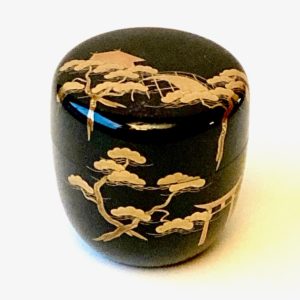
The seasonal division of the solar calendar called Bō-shu, 芒種, Grain beard-seed, is the start of the Uma-no-tsuki, 午の月, Horse-’s-month, which is protected by Sei-shi Bo-satsu, 勢至菩薩, Strength-attain Grass-buddha, the Buddha of Wisdom. Seishi Bosatsu and Kannon Bosatsu, the Buddha of Mercy, accompany A-mi-da Nyo-rai, 阿弥陀如来, Praise-increase-steep Like-become, the Buddha of Compassion. In the yo-jō-han, 四畳半, four-mat-half, cha-shitsu, 茶室, tea-room, Seishi is metaphorically located in the south, in the middle of the south wall, opposite Kannon in the north. Amida is guardian in the northwest corner of the room. Seishi’s monthly day of dedication, en-nichi, 縁日, edge-day, is observed on the 23rd day, which coincides with a half-moon, han-getsu, 半月.
The cha-shitsu, 茶室, tea-room, especially the yo-jō-han, 四畳半, four-mat-half, is more than a single room, and may have two or more adjoining rooms. The chashitsu itself in which the Tea is prepared and drunk by the guests, the toko-no-ma, 床の間, floor-’s-room, where the revered scroll, flowers, incense container, etc. are placed, and the mizu-ya, 水屋, water-room, where the tei-shu, 亭主, house-master, prepares for the Tea presentation. In some Tea rooms, the ceiling may have different levels or angles that would indicate separate ‘rooms’.
Buddhist deities are ideologically everywhere, and eight particular deities preside over the Tearoom. Kannon in the North, Kokūzō Bosatsu – Northeast, Monju Bosatsu – East, Fugen Bosatsu – Southeast, Seishi Bosatsu – South, Dainichi Nyorai – Southwest, Fudō Myō-ō – West, Amida Nyorai – Northwest. The tokonoma in the North is guarded by Kannon, the area in the Northwest where the Tea is prepared is guarded by Amida.
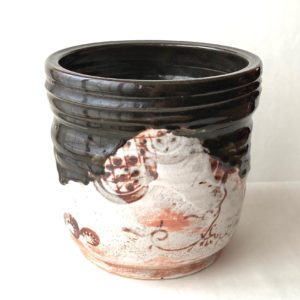
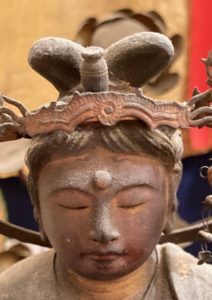
In the traditional mizu-ya, 水屋, water-room, where preparations are made for a Tea gathering, the principle feature is water, which is held in a large mizu-game, 水瓶, water-bottle. Seishi Bosatsu has on his head a sui-byō, 水瓶, water-bottle, which contains sanctified water, also called kan-ro, 甘露, sweet-dew, the Buddhist elixir of life. Thus, Seishi may be the guardian of the mizuya, and so the Chashitsu complex of rooms is symbolic of the Amida San-zon, 阿弥陀三尊, Amida Three-lords, including Kannon and Seishi. Rikyū’s favorite kama, 釜, kettle, was the Amida-dō gama, 阿弥陀堂, Amida-hall kettle.
Another essential feature of the mizuya, is a heat source to heat water. There is always a need for hot water independent of that in the Tearoom. Heat is provided by a charcoal fire in a fu-ro, 風炉, wind-hearth, or a gan-ro, 丸炉, round-hearth, that is set in the floor. In modern times, an electric burner is often used for the kama. A much-appreciated source of heat in winter, a possible scourge in summer. In former times, and at present as well, tea was prepared in the mizuya and brought out to guests assembled in the Tearoom. The furo and the ganro are used to heat the charcoal used in the furo or ro in the Tearoom.
Seishi Bosatsu is the protector of the Buddhist San-zu, 三途, Three-routes, which are the lower three realms of the Roku-dō, 六道, Six-ways: hi-to, 火途, fire-route, chi-to, 血途, blood-route, and katana–to, 刀途, sword-route. These are the realms of the animals, hungry ghosts, and hell.
Preparing tea in one room and served to guests in another room was the mode of Tea presentations in the 15th century in the Dō-jin-sai, 同仁斎, Equal-benevolence-abstain, tearoom, of the Tōgudō, 東求堂, East-request-hall, at Gin-kaku-ji, 銀閣寺, Silver-pavilion-temple, Kyōto. Tea was prepared in the adjoining room, and served to guest in the yojōhan, where there was no heat source for hot water. In essence, the manner of preparing tea in the adjoining room, became the ‘real’ Tea ceremony place, where the maker of the tea became identified as teishu, and the assistants became the kyaku. The ‘guests’ gathered in the ‘tearoom’ became incidental. The room, Dōjinsai, was created by Ashikaga Yoshimasa to study and practice Pure Land Buddhism. Drinking Tea was a part of his practice. Later, the Dōjinsai became identified as a ‘Tearoom’. The main room of the Tōgudō is the Butsu-ma, 仏間, Buddha-room, which is for the worship of Amida Nyorai.
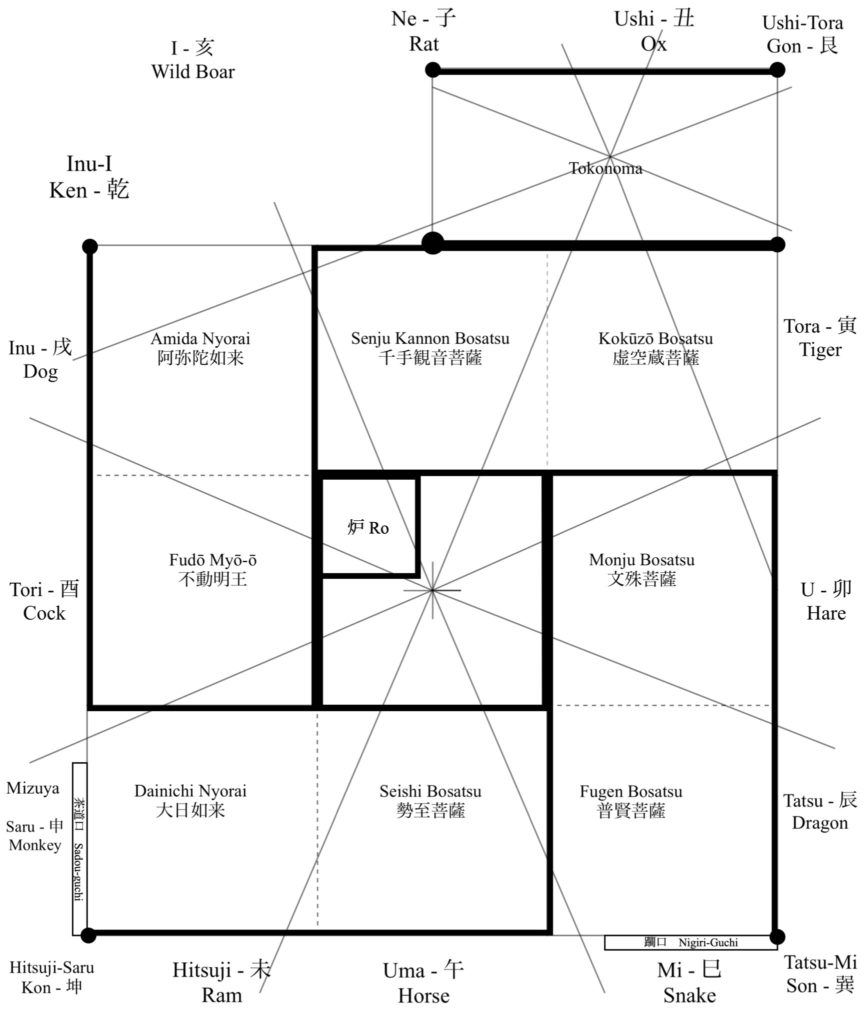
The southern location of Seishi is the same location of the tsume, 詰め, closer, the last of the (four) guests at an ideal Tea gathering. The tsume may assist the teishu, and is the only guest that is allowed to enter the mizu-ya, 水屋, water-room, where the teishu makes preparations for a Tea gathering. In practice, during the Tea proceedings, the tsume does not actually sit in Seishi’s place, but rather in the southeast corner of the room, next to the third guest.
Ge-shi, 夏至, Summer-attain, the summer solstice, occurs on the 21st of June, and is the zenith of Seishi’s guardianship. In the 24-hour day, noon is the equivalent of the equinox, and is called Shō-go, 正午, Correct-horse. The Shō-go Cha-ji, 正午茶事, Correct-horse Tea-matters, is the most complete Tea gathering held at noon, and includes go-zumi, 後炭, latter-charcoal, rebuilding the charcoal fire after the presenting koi-cha, 濃茶, thick-tea.
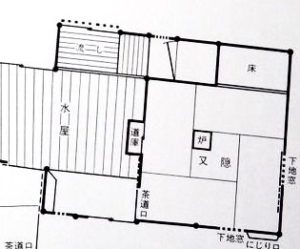
It is interesting to note the concept of the word ‘room’ in Japanese. There are three Japanese words for ‘room’: ma, 間, which also means interval, space, etc.; shitsu, 室, also means apartment, chamber, greenhouse, cellar, wife, scabbard, Chinese constellation, etc.; ya, 屋, also means roof, house, shop, dealer, seller, etc. The name of the ie-moto, 家元, house-origin, of Urasenke is Sen Sō-shitsu, 千宗室, Thousand Sect-room.
The yojōhan is based on the hut of the great Buddhist sage, Yuima. Yuima is the Japanese for Vimalakirti. Yui-ma-kitsu, 維摩詰, Rope-rub-close, was a contemporary of the Buddha, who hosted countless Buddhist deities in his ten-foot square hut, which is the model of the yojōhan chashitsu. Perhaps it is pure coincidence that part of Yuimakitsu’s name Kanji, 詰, kitsu, is the same Kanji for tsume. Kitsu, tsume, 詰 , packed, close, pressed, reprove, rebuke, blame, etc.
When a guest enters the yojōhan chashitsu each person goes to the tokonoma and the ten-mae-za, 点前座, offer-fore-seat, and temporarily sits in the location guarded by Seishi, while other guests move about the room. In this way, each guest may be identified with Seishi and perhaps, ultimately, Yuima.
When everyone has finished, the guests sit along the East wall of the room, facing West. The East is protected by Mon-ju Bo-satsu, 文殊菩薩, Literary-exceptional Grass-buddha, who had one of the great theological debates with Yuima. Monju had advised Yuima as to the manner of how to accommodate the seating of the myriad Buddhist deities in his small hut. The customary Japanese word for room is he-ya, 部屋, section-room. The tsume, or o-tsume, お詰め, is also called the ba-kkyaku, 末客, last-guest. There may be wordplay on ba-kkyaku, 祓却, exorcise-withdraw, which is a concept of Shin-tō, 神道, God-way.
In the Shintō cosmology, Su-sa-no-o no Mikoto, 須佐之男命, Necessarily-help-’s Male’s Highness, is the younger brother of Ama-terasu O-mi-kami, 天照大御神, Heaven-brightener Great-hon.-god, the sun goddess. She was born from the left eye of I-za-na-gi no Mikoto, 伊邪那岐命, That-wicked-what-branch ’s Lord, and her brother, Tsuki-yomi no Mikoto, 月読命, Moon-read’s Lord, was born from the Izanagi’s right eye, and became the moon god. Susano-o was born from Izanagi’s nose, when Izanagi bathed himself after trying to rescue from the underworld, his wife, I-za-na-mi no Mikoto, 伊邪那美命, That-wicked-what-beauty’s Lady.
Susano-o, jealous of Amaterasu, in vengeance, broke down the earth works that held the water in her ricefield, defecated in her throne room, flayed a piebald colt, and threw the pelt into her weaving chamber. Susano-o’s horse was called ama-no-fuchi-koma, 天斑駒, heaven-mottled-horse, piebald. A familiar Japanese thing that is related to the horse is the formal hakama, 袴, divided trouser/skirt, that was introduced long ago from Korea, and worn when riding a horse. Susano-o is associated with Izumo, 出雲, Our-cloud, which is identified with horses, and horses are often the messengers of the gods, and as well as their mounts. One of the important horses in Shintō brings the deity, Ka-mo-wake-ikazuchi no Ō-kami, 賀茂別雷大神, Upper-joy-lux-fork-lightning Great-god, from heaven to the Kami-ga-mo Jin-ja, 上賀茂神社, Upper-Joy-lux God-shrine; Kamo is the name of an ancient clan in the upper regions of the eponymous Kamo River.
One of ancient Japanese legends, one of Amaterasu’s weaver maids, frightened by the mayhem, stabbed herself in the pudendum with a spindle, and died. Appalled, Amaterasu fled into the Cave of Heaven, and sealed the entrance with the Ame-no-iwa-to, 天の岩戸, Heaven’s stone-door. Plunged into darkness, the eighty myriad gods assembled to coax her out of the cave. Ame-no-u-zu-me-no-mikoto, 天宇受売命, Heaven-’s-roof-float-sell-lord, before the cave stone, revealed her sex, and danced madly on a sake barrel, and sang, causing the assembly to laugh. The name Uzume is written with many different Kanji, however, the original name may have been written Ame-no-usu-me, 天の臼女, Heaven-‘s-mortar-woman: the Kanji usu, 臼, mortar, altered to read uzu, meaning the vortex of the heavens. Curious, Amaterasu moved away the stone, returning her light to the world. Ame-no-ta-jikara-o no mikoto, 天手力男命, Heaven-‘s-hand-strength-male-lord, held back the stone. Amaterasu was given treasures including the Ya-ta-kagami, 八咫鏡, Eight-span-mirror, the Kusa-nagi-no-tsurugi, 草薙劍, Grass-mow-’s-sword, and the Maga-tama, 勾玉, Curved-gemstones, which comprise the sacred imperial regalia: the San-shu no Jin-gi, 三種の神器, Three-kinds ’s Three-containers. Other offerings included blue and white strips of fabric.
This entire incident has various interpretations. One is the changing of the seasons, with the sun obscured somewhat during the winter, and with the turning of the heavens, spring comes. Uzume becomes O-ta-fuku, お多福, O-much-fortune, who represents the fecundity of spring, and features in the celebrations of Setsu-bun, 節分, Spring-divide. Setsubun is the eve of Ri-sshun, 立春, Start-spring, which is halfway between the winter solstice and the vernal equinox. In modern times, the important event after Risshun is Hatsu-uma.
Hatsu-uma, 初午, is the first day of the Horse in the second lunar month. In the past, the observance was held on the first day of the Horse in the third lunar month, close to the time of rice-planting. Certain lunar months have three days of the Horse, which may cause disorder in the rainy season.
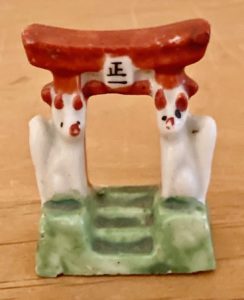

The origin of Hatsu-uma, 初午, First-horse, is when U-ka no Mitama no Kami, 宇迦の御魂神, Heaven-(sound) ’s Hon.-spirit-god, the goddess of rice and foodstuffs, descended to the Ina-ri Jin-ja, 稲荷神社, Rice plant-carry God-shrine, on the first day of the Horse in ancient times. Uka no Mitama is also known as O-inari-san, お稲荷. Her messenger is the kitsune, 狐, fox, a white fox in particular. Foxes are believed to enjoy eating age-dō-fu, 揚げ豆腐, deep-fried bean-curd, called inari-age, いなり揚げ.

Pockets of agedōfu are stuffed with seasoned cooked rice, and called inari zu-shi, いなり寿司, which is loved by nearly every Japanese. In the Kan-tō, 関東, Barrier-east, area, inari zushi is rectangular like kome-dawara, 米俵, rice-bale, and in the Kan-sai, 関西, Barrier-west, area they are san-kake, 三角, three-corner, triangles like fox ears. Because of its deep-fried oiliness, it is unsuitable for a Tea.
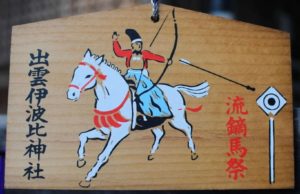
Part of ancient Shintō rituals and customs is yabusame, 流鏑馬, flow-arrowhead-horse, which is archery on horseback. One of the great annual events in Kyōto is the yabusame held at Kami-ga-mo Jin-ja, 上賀茂神社, Upper-Joy-lux God-shrine; Kamo is the name of an ancient clan in the upper regions of the eponymous Ka-mo–gawa, 賀茂川, Joy-lux River.
As the archer on his galloping horse runs the course, he shoots an arrow at each of three targets. On the back of some targets is written, Maga-tsu Hi-no-kami bakkyaku, 狂津日神祓却, Mad-port sun-’s-god exorcism-dispel. This deity is also known as Maga-tsu Hi-no-kami, 禍津日神, Calamity-haven Sun-’s-god.
Fire is present in each of the three rooms of the chashitsu. In the tokonoma, there is the rō-soku, 蝋燭, candle, and the incense in the kōgō. In the chashitsu there is the fire in the furo or the ro. In the mizuya, there is the fire in the gan-ro, 丸炉, round-hearth. There is water in the three rooms. Water in the hanaire in the tokonoma, water in the mizusashi in the chashitsu, and water in the mizugame in the mizuya. The water and the fire are essential elements in the offerings to the Buddhas.
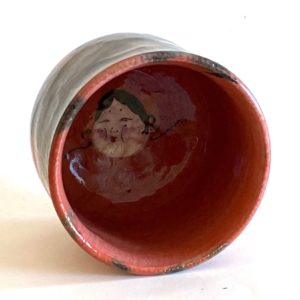

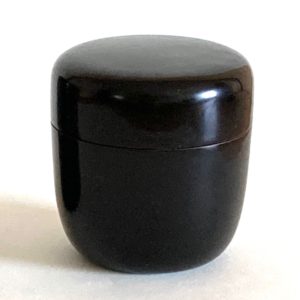
Left: cha-wan, 茶碗, tea-bowl, ceramic with red glaze and image of O-ta-fuku, お多福, O-much-fortune, Ya-saka yaki, 八坂焼, Eight-slope fired, Raku-yaki, 楽焼, Pleasure-fired, Kyōto. Center: cha-shaku, 茶杓, tea-scoop, take, 竹, bamboo, naka-bushi, 中節, middle-node, by Kuro-da Shō-gen, 黒田正玄, Black-field Correct-mystery, named, ‘Te wo toriatte’, 手をとりあって, Hand taking hand, by Hō-un-sai, 鵬雲斎, ‘Phoenix’-cloud-abstain, XV Iemoto, Urasenke. Right: Rikyū-gata chū-natsume, 利休形中棗, Rikyū middle-jujube, black-lacquered turned wood, tea container.
Some of the utensils for making tea may be symbolic of the three imperial regalia. The cha-wan, 茶碗, tea-bowl, especially when containing water, resembles a mirror. The chashaku may be likened to a sword, and bamboo is a kind of grass, which is part of the name of the imperial sword, Kusa-nagi-no-tsurugi, 草薙劍, Grass-mow-‘s-sword. The natsume tea container is emblematic of sun, which is the supreme hō-ju, 宝珠, treasure-jewel. The term maga-tama, 勾玉, curved-gem, is symbolically manifested in the design of the tai-kyoku, 太極, great-extreme. When holding the natsume tea container, the hand covers half of the lid, which is termed, han-getsu, 半月, half-moon.
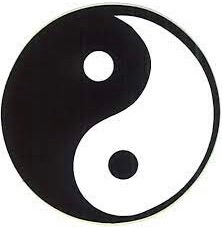
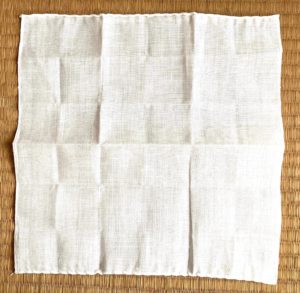
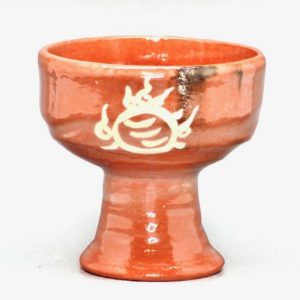
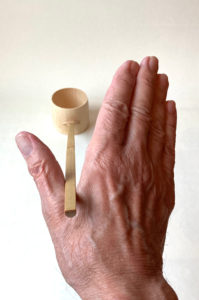
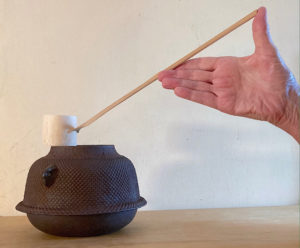
When handling the hi-shaku, 柄杓, handle-ladle, with the right hand, the teishu places and takes up the ladle with gestures that are likened to archery. Oki-bishaku, 置き柄杓, place-ladle, placing the arrow on the bow; tori-bishaku, 取柄杓, take-ladle, hiki–bishaku, 引き柄杓, draw-ladle, drawing the bow; kiri-bishaku, 切柄杓, cut-ladle, releasing the arrow.
For further study, see also: Tea in June, Roku-Gatsu, and Tango no Sekku

